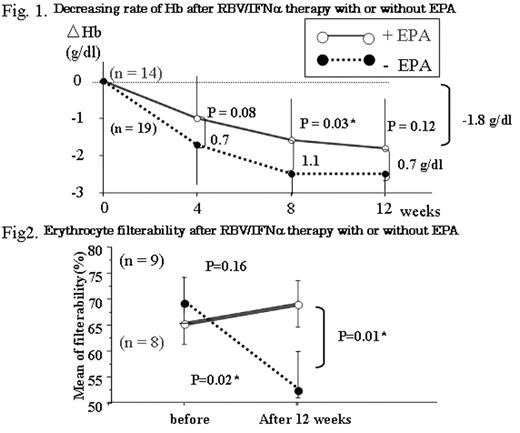Abstract
Ribavirin(RBV)is a water soluble synthetic guanosine analog that exerts antiviral activity against DNA and RNA viruses after intracellular phosphorylation. Current studies indicate that combination therapy with RBV and Interferon a (IFNa) is associated with higher rates of sustained virological and biochemical response compared to IFN a monotherapy for chronic hepatitis type C (CHC). Hemolytic anemia is the major side effect of the therapy, with 67% of treated patients developing anemia. The exact mechanism for RBV-related anemia is unknown, but it is thought to be decreasing deformability of eythrocytes resulting from accumulation of phosphorylated RBV in erythrocytes. Highly purified eicosapentaenoic acid (EPA) is widely used for the treatment of hyperlipidemia and atherosclerosis in Japan. We have investigated that EPA has a beneficial effect in patients with RBV-related anemia (
Our aim of this study is to establish the safer treatment of RBV/IFNa using EPA for CHC patients and elucidate the mechanism of EPA action for improving anemia.
[Patients and methods] Thirty three patients with CHC were randomized to RBV/IFNa therapy (800mg/6MU/day) with or without EPA (1800mg/day) for 12 weeks (14:+EPA; 19:-EPA). Erythrocyte filterability (Nickel mesh filtration method;
[Result] As shown in Fig. 1, hemoglobin (Hb) levels decreased in both groups by the treatment. However, decrease of Hb levels significantly attenuated by the addition of EPA at 4 and 8 weeks after initiation of the treatment. This effect continued for 12 weeks. Initial mean erythrocyte filterability (%) at study entry was 65.3% and 68.1% in the + and -EPA group, respectively. After 12 weeks treatment, improvement of erythrocyte filterability occurred in 6/8 patients in the +EPA group. In contrast, 7/9 patients resulted in the decrease of erythrocyte filterability in the -EPA group. As shown in Fig 2, the mean erythrocyte filterability (%) for the +EPA group was 71.0%, against 51.4% in the -EPA group (P=0.01) after 12 weeks.
[Discussion and Conclusion] EPA significantly attenuated the anemic effect of RBV/IFNa therapy for CHC patients. Erythrocyte filterability decreased in the -EPA group. On the contrary, decrease of erythrocyte filterability was not found in the +EPA group. Therefore, EPA improved the anemic side effect of RBV/IFNa via the stabilizing action of the membrane by amelioration of erythrocyte filterability. This study would be useful for clinical application.
Author notes
Corresponding author


This feature is available to Subscribers Only
Sign In or Create an Account Close Modal